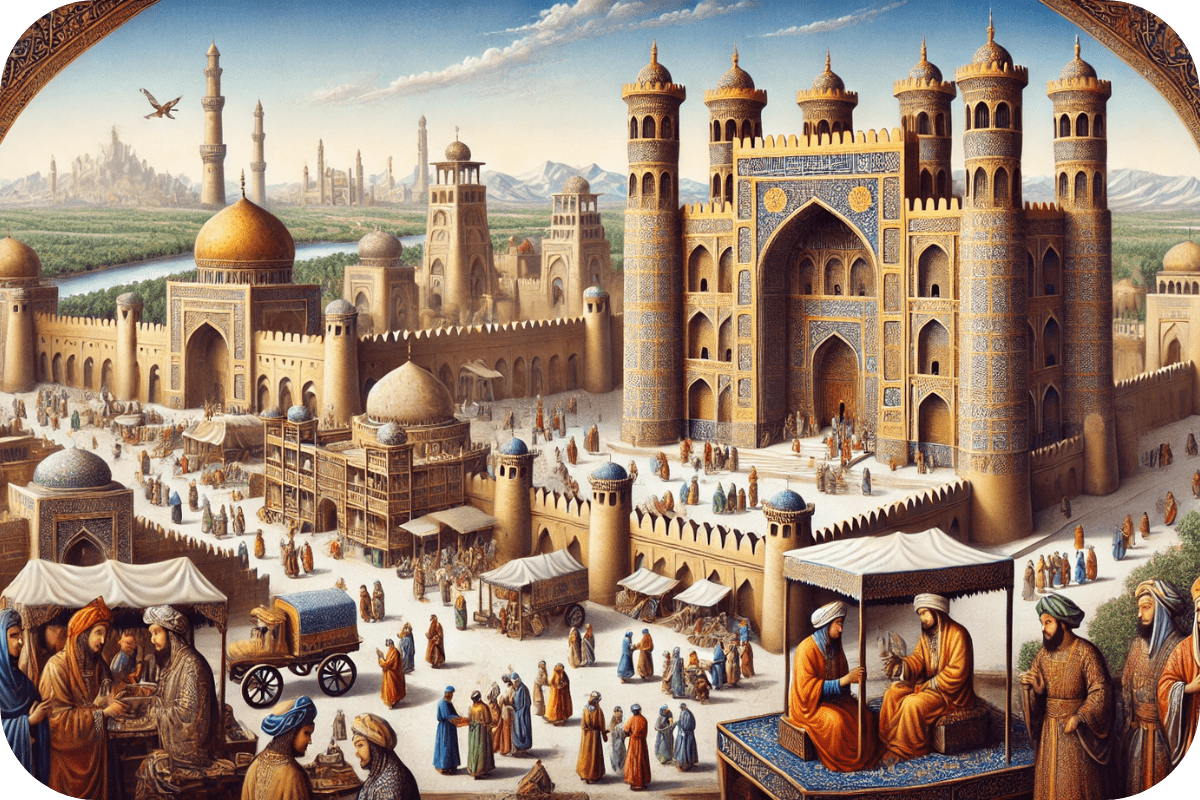The Zengid Dynasty was a prominent Muslim dynasty that played a vital role in shaping the political and military history of the Middle East during the 11th and 12th centuries. It was founded by Imad al-Din Zengi and included parts of the Levant (Syria) and Upper Mesopotamia (Iraq).
The Zengid dynasty became famous in the Islamic world for its successes against the Crusaders and its pivotal role as the foundation from which Saladin emerged: one of the most famous and courageous Muslim commander.
This article explores the origins, achievements, and eventual decline of the Zengid Dynasty and presents its enduring legacy in Islamic history.

Origins of the Zengid Dynasty
The Zengid Dynasty traces its roots to Imad al-Din Zengi, a Seljuk Turk born around 1085. Zengi served as the atabeg (governor) of Mosul, a key city in northern Iraq, under the Seljuk Sultan. His exceptional leadership skills, strategic thinking, and military prowess helped him rise to prominence in the Seljuk Empire. In 1127, Zengi was appointed as the atabeg (governor) of Mosul and Aleppo, laying the foundation of the Zengid Dynasty.
At this time, the Muslim world was fragmented, with various rulers and dynasties competing for power. The Seljuk Empire itself was weakening due to internal divisions. The arrival of the Crusaders in the late 11th century further complicated the political landscape. In this chaotic environment, Zengi sought to unite the Muslim lands and counter the Crusader threat.
Imad al-Din Zengi and His Achievements
Imad al-Din Zengi is best remembered for his efforts to reclaim Muslim territories occupied by the Crusaders. One of his most significant achievements was the conquest of the Crusader-held city of Edessa in 1144 after a siege. This victory marked a turning point in the Crusades, as Edessa was the first major Crusader state to fall back into Muslim hands. The event sent shockwaves through Europe and inspired the launch of the Second Crusade.
Zengi’s success in Edessa was not merely a military triumph; it also reinvigorated the Muslim spirit and provided a blueprint for future leaders to continue the struggle against the Crusaders. Unfortunately, Zengi’s life was cut short in 1146 when he was assassinated by one of his own servants.

The Rule of Nur al-Din Zengi
After the death of Imad al-Din Zengi, his son Nur al-Din Zengi (Nureddin Zengi) took control of Aleppo and quickly established himself as a capable and visionary leader. Nur al-Din’s reign (1146–1174) marked the zenith of the Zengid Dynasty. He continued his father’s mission of uniting the Muslim lands and resisting the Crusaders.
Nur al-Din implemented significant reforms in governance, administration, and the military. He was deeply committed to justice and is remembered as a pious ruler who prioritised the welfare of his people. Under his leadership, Aleppo became a centre of Islamic learning and culture.
One of Sultan Nuruddin Zangi most remarkable achievements was his successful unification of Syria and parts of Iraq under Zengid control. Nur al-Din appointed Saladin as the governor of Egypt, effectively extending Zengid's influence over the region. This move proved instrumental in the eventual Muslim recapture of Jerusalem from the Crusaders in 1187.
Are you interested in reading about Islamic history topics like Saladin, the Crusaders, and the Zengid Dynasty? Well, then, check out the Riwaya Islamic Books Section. We offer a vast collection of books on history, theology, spirituality, tafsirs, etc., that you will surely find interesting.
Expansion of the Zengid Rule
After the decline of the Seljuk Empire and the death of Ahmad Sanjar in 1157, the Zengid dynasty, though nominally under Seljuk authority, operated independently and began expanding its influence. During the reign of Nur ad-Din (1146–1174), the Zengids consolidated their rule, adding territories such as Tripoli, Yemen, the Hejaz, and Anatolian lands up to Sivas.
A significant focus of the Zengid dynasty was its campaigns in Egypt against the Fatimid Caliphate from 1163 to 1169. These campaigns began when Shawar, the Fatimid vizier, sought Nur ad-Din’s support to reclaim his position after being ousted by his rival Dirgham. The first campaign in 1163 successfully reinstated Shawar, but tensions arose when Shawar demanded that Shirkuh withdraw his forces. Shirkuh refused, citing Nur ad-Din’s orders, leading to a prolonged Zengid presence in Egypt.

In 1167, the Zengids, led by Shirkuh and his nephew Saladin, launched a second campaign in Egypt, culminating in the Battle of al-Babein near Giza. Despite initial Crusader-Egyptian success, the Zengids secured victory and advanced to Alexandria, where they fortified their position.
In 1168, the Crusaders besieged Cairo, prompting another Zengid intervention. Shirkuh's forces compelled the Crusaders to retreat, allowing him to seize Egypt in 1169. Later, he was appointed vizier under Fatimid caliph al-Adid, which brought Egypt under Zengid control but he died shortly after. Saladin succeeded him, consolidated power, and aligned Egypt with the Sunni Abbasid Caliphate, ending the Shia Fatimid Caliphate by 1171.
Cultural Contributions of the Zengid Dynasty
Here are some key cultural and architectural contributions of the Zengid dynasty in the territories they ruled:
Literature
During the 12th and 13th centuries, the Zengid era witnessed a surge in decorative arts and illustrated manuscripts despite religious opposition to depicting living beings. This period blended influences from Christian Syriac and Byzantine art, evident in works like the Maqamat al-Hariri. The Kitab al-Diryaq, a medical manuscript on antidotes, was beautifully illustrated and reflected the cultural and social context of its time, with one version created in Mosul in 1198–1199.

Architecture
The Zengids made significant architectural contributions, particularly in Syria and Iraq. They fortified the Citadel of Aleppo and rebuilt the city walls to defend against Crusaders. Nur ad-Din Zangi, a key ruler, also constructed a palace, mosques, and a grassy racecourse in Aleppo. He added a wooden mihrab to the Mosque of Abraham and restored other important sites.

In Damascus, Nur ad-Din established the Nur al-Din Madrasa in 1167, combining a mosque, a school, and his mausoleum. He also built the Nur al-Din Bimaristan, a medieval hospital, in 1154, highlighting advancements in healthcare and education during the Zengid period.
Visit the Riwaya Islamic wall art section if you want to decorate your house walls and living spaces with beautiful wall art designs inspired by Islamic architecture and manuscripts. Our collection offers Quranic verses, names of Allah, and geometric designs/ patterns in different sizes. Shop now for yourself or as a gift for someone on a special occasion.
Decline and End of the Zengid Dynasty
Despite its early successes, the Zengid Dynasty began to decline after Nur al-Din died in 1174. His successors lacked vision and leadership, leading to internal divisions and weakened authority. The territories Nur al-Din had painstakingly united began to fragment as rival factions emerged. Saladin, who had grown increasingly powerful in Egypt and had been appointed by Nur al-Din himself, used the opportunity to consolidate his own power.
By 1181, Saladin had effectively taken control of much of the former Zengid territory, uniting Egypt and Syria under his rule and establishing the Ayyubid Dynasty. This marked the end of Zengid's dominance in the region. While the Zengids continued to rule in a diminished capacity in Mosul and other areas, their influence waned significantly. The dynasty's remnants eventually fell to the Mongols and other rising powers in the early 13th century.
Legacy of the Zengid Dynasty
The Zengid Dynasty left an indelible mark on Islamic history. Their efforts to resist the Crusaders and unify the Muslim world served as a source of inspiration for future generations. Imad al-Din Zengi and Nur al-Din Zengi are remembered as exemplary leaders who combined military prowess with a commitment to justice and piety.
Architecturally, the Zengids contributed to the development of Islamic art and culture. They built mosques, madrasas, and other public works that enhanced their cities' cultural and spiritual life. For example, the Great Mosque of Aleppo was renovated and expanded under Nur al-Din’s patronage, reflecting his dedication to fostering Islamic learning and devotion.
The dynasty’s role in facilitating the rise of Saladin and the Ayyubid Dynasty cannot be overstated. By laying the groundwork for the eventual recapture of Jerusalem, the Zengids played a pivotal role in shaping the course of the Crusades and the broader history of the Islamic world.

Conclusion
The Zengid Dynasty holds a special place in Islamic history. They stood out for their bravery in fighting the Crusaders and their efforts to unite Muslim lands. Imad al-Din Zengi and Nur al-Din Zengi were strong leaders who inspired many with their justice and piety.
Even though the dynasty declined after Nur al-Din’s death, their legacy continued through Saladin, who rose to power and achieved great victories like reclaiming Jerusalem. The Zengids remind us of the importance of unity and strong leadership in difficult times, leaving behind a story of resilience and dedication that still inspires today.
Selling on Riwaya
Are you planning to sell your Islamic products online?
Riwaya is the UK’s largest Islamic marketplace, designed to connect Muslims with businesses that share their faith and values. Our platform offers a variety of product categories, including modest clothing, Islamic books, wall art, home decor, jewellery, etc.
Joining Riwaya comes with great benefits. Enjoy your first month free, along with free marketing, SEO support, and access to a thriving Muslim community.
Sign up and start growing your business with Riwaya today!



















































